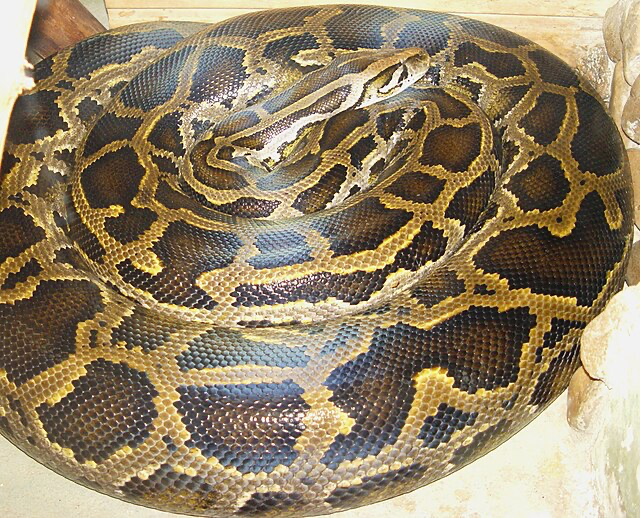by Margaret Dedloff
The Everglades National Park is an area of land larger than 2,000 square acres in South Florida. The Everglades are filled with wildlife, including reptiles like turtles, alligators, crocodiles, and snakes. While there are many species of snakes that are native to the Everglades and South Florida, including cottonmouths, green water snakes, and eastern hognose snakes, one of the most common snakes that can be seen in the Everglades is an invasive species of snake, the Burmese python (figure 1). An invasive species is an animal that is not naturally found in a certain area, but has been introduced through some sort of human activity.

Figure 1. A Burmese python in captivity. Image source.
Burmese pythons are large, nonvenomous snakes that are native to the jungles in southern China, Burma, Indochina, Thailand and the Malay Archipelago. They are some of the largest snakes on earth, growing up to 23 feet long – about the length of a garbage truck! Burmese pythons are also very heavy snakes, weighing up to 200 pounds when full grown, and being as thick as a telephone pole. To grow that big, Burmese pythons have to eat a lot – they are generalist predators, meaning that they will eat pretty much anything they can catch, including mammals, birds, and other reptiles. Burmese pythons don’t have great eyesight, so they use chemical and heat receptors to sense their prey. Once they catch their meal, they use their heavy bodies to squeeze their prey and then swallow them whole!
Burmese pythons first appeared in South Florida and the Everglades in the 1980s. These snakes tend to be the large snake of choice for reptile owners as they are not very aggressive pets. Because of their popularity in the pet industry, it is not uncommon for irresponsible owners who become overwhelmed with caring for such a large snake to release them into the wild. The warm, wet habitat of the Florida Everglades is very similar to the native habitats of the Burmese python. Additionally, there are no natural predators of Burmese pythons in South Florida, making it easy for these snakes to grow and reproduce without being hunted. While Burmese pythons have been found in the Everglades since the 1980s, their population exploded after Hurricane Andrew in 1992 when a Burmese python breeding facility was destroyed, releasing potentially hundreds of Burmese pythons into the Everglades. The increase in Burmese pythons in the Everglades has had serious consequences on the ecosystem. A study by wildlife biologists found that between 1997 and 2012, populations of raccoon and opossums have decreased by ~99%, likely due to the vast increase in the Burmese python population.
Burmese pythons are considered one of the most concerning invasive species in Florida. To try and decrease the impact these snakes are having on the ecosystem, the state of Florida has started hiring python removal agents to hunt, find, and humanely euthanize Burmese pythons in the Everglades and South Florida. Additionally, it is legal in Florida to hunt Burmese pythons year round without a license. There are also contests held, like the Florida Python Challenge, where people can compete to see who can capture and remove the most Burmese pythons from the Everglades. While these efforts are helpful, there are still hundreds of Burmese pythons still in the Everglades and South Florida. The best way to combat invasive species, like the Burmese python, is to prevent their invasion in the first place by practicing responsible pet ownership.
